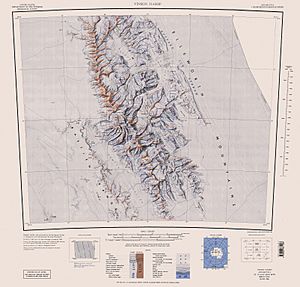Sullivan Heights facts for kids
Sullivan Heights (78°19′S 85°3′W / 78.317°S 85.050°W) is a group of mountains in Antarctica. These mountains are found in the western part of the continent. They are part of the Sentinel Range in the Ellsworth Mountains.
The tallest point in Sullivan Heights is Mount Levack, which stands about 2,760 m (9,060 ft) tall. The whole area is shaped a bit like an oval. It stretches for about 11 nautical miles (20 km; 13 mi) (about 20 kilometers). Sullivan Heights has sharp mountain peaks, rough ridges, and steep cliffs around its edges.
Several glaciers flow around and through Sullivan Heights. These include the Crosswell Glacier, Ellen Glacier, and Dater Glacier. Inside the heights, you can also find the Pulpudeva Glacier and Strinava Glacier. A place called Vranya Pass separates Sullivan Heights from the Vinson Massif to the south.
Why is it Called Sullivan Heights?
Sullivan Heights was named in 1997. The Advisory Committee on Antarctic Names (US-ACAN) chose the name. They named it after Cornelius Wayne Sullivan. He was an American oceanographer, which means he studied the oceans.
Cornelius Sullivan was born in 1943. He led teams for the United States Antarctic Program (USAP). These teams studied tiny living things in the sea ice near McMurdo Sound from 1980 to 1989. He was also a main scientist for projects called AMERIEZ. These projects looked at marine life near the edge of the ice in the Weddell Sea during the 1980s.
Later, he became a professor of biological science. He also directed the Office of Polar Programs at the National Science Foundation from 1993 to 1997.
Mountains and Glaciers in Sullivan Heights
Sullivan Heights is home to several important geographical features. These include mountains, glaciers, and passes. A pass is a low point between mountains that makes it easier to travel through.



